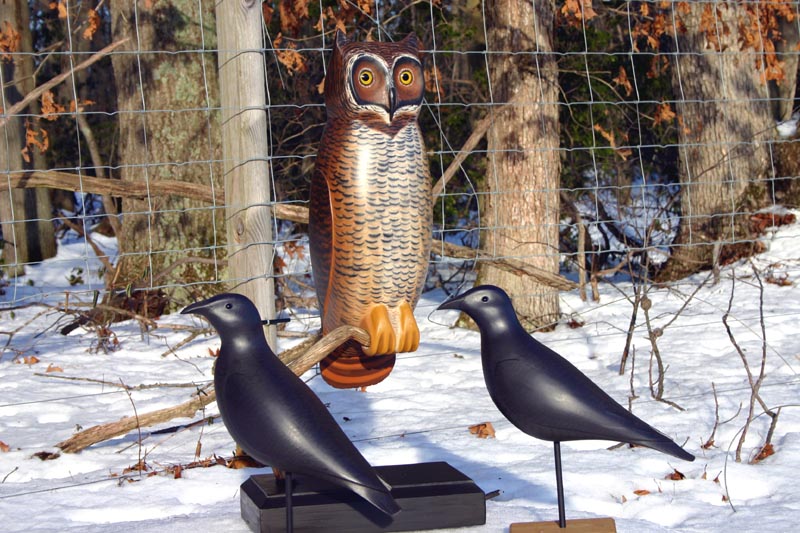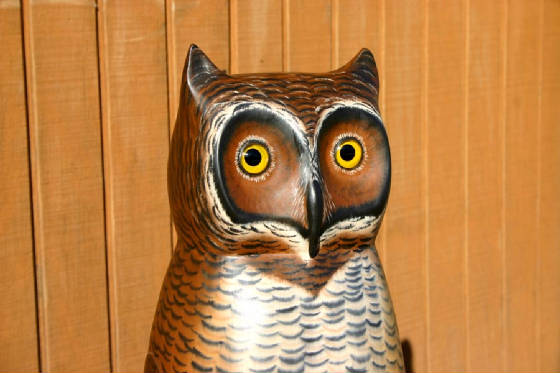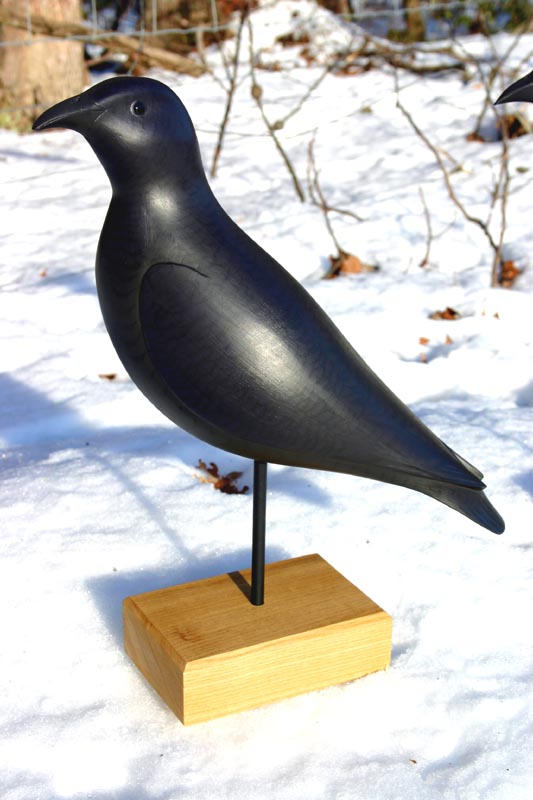John Lawrence
Active member
Last year at the beginning of February we had a 26" snow fall. This morning I awoke to find about a 1/2" of ice due to a freezing rain and more still accumilating. With our hills things are unpassable for the time being.
But anyway February brings us a little closer to spring and with that the Westlake Show. Here is some of what is currently on my workbench. I was able to steal a couple of hours to work on my petite hen wood ducks last week. I get a lot of questions about painting and one of the biggest is about how to mix grays. When I painted the wood duck heads the base I used before color glazing was a gray mix. When I mixed the base gray I started with a small amount of Burnt Umber and French Ultramarine Blue. I tempered that mix with Unbleached Titanium White. You can adjust this gray mix to either warm or cool by varying the amount of brown or blue too your tastes. I usually tend towards warmer in my color mixes so I had slightly more brown. The value or darkness is adjusted by the amount of white added. And of course the thickness of the paint is adjusted by the addition of mediums, which also help with curing time and sheen. After I had the right relationships of light and dark grays I glazed in colors. The hen wood duck is one of my favorites to paint. So many times I see people paint them in a drab bluish gray, well as you can see my eyes see them completely differently. They are a very vibrant bird and I like to portray them accordingly. I did do an additional glaze to the fronts of the scapulars (back feathers). For this mix I used some Brown Madder, Rose Madder and Diox Purple in about equal amounts. I thinned with my mediums and applied with a soft brush. I was trying to achieve a look wherein the original colors are still there but are muted by a little darkness. Just the bills to paint now and they will be done.
View attachment P1310172.jpg
And here is a head shot of one of the heads.
View attachment P1310173.jpg
This is a drake Oldsquaw that I started on Saturday. My plans are to have it completely carved and hollowed by the end of the week and the off to be painted. He's cedar and magnum sized. The tail will be cut from a piece of Black Locust that was cut in my yard a few years ago.
View attachment P1310176.jpg
And this is the hen ringneck that I showed you last month along with the drake that will pair up with her. One of the most interesting things about ringnecks are the different shapes that the head can take on. To me the slope from the top of the head to the tip of the bill is very eye catching so that is what I tried to emphasize on these decoys. Just about done sanding and then sealer and paint.
View attachment P1310177.jpg
At the suggestion of many of my friends and just about all of my family my wife and I started a web page for my decoys. I've taken a lot of time to review other decoy web pages and I want to do something different. So what I have included are sections for works in progress and also a link to a blog/conversations where I plan on having an ongoing discussion particularly about oil painting techniques. It is a work in progress to the point that I noticed that we didn't ad any contact information to it (that will be corrected later this morning) but it's a beginning. If you find yourself with a little extra time please take a look a www.johnlawrencedecoys.com.
And with that stated we are going to try and produce a video on the oil painting techniques that I use. What I plan to do is take you step by step through the whole painting process in which I'll discuss the brands and styles of paint I use, brushes, methods of applications including the color glazes I write about and mediums and the such. We are looking at something in the range of 2-2/1/2 hours in length. If we can get this to work I plan on having it with for sale at Westlake in March. That may be a little ambitious though. My plan is to paint the hen ringneck pictured above in this video. I've never seen any that focus on that bird and it seems to be a popular one to make, and the techniques can be used on any of the divers species.
A couple of weeks ago I had one my friends over on a Saturday morning. I've given lessons to this fellow for some time and he had asked me repeatedly to just come and watch me paint. In my acrylic and airbrush days I did many painting demonstrations but since switching back to oils I haven't done any. I painted the tails and rumps on two decoys while he watched and I narrated what I was doing and why. He kept saying "That looks easy, that looks like fun" and it was and is. And when I painted the tail coverts in just a few minutes he said "I could do that" and you could too. With a relatively small investment in materials, much of which you can get in your own neighborhood, you can get into painting with oils. Really just a few tubes of paint, a few brushes and a can or two of turpentine you can enjoy painting your decoys in oils. There isn't any rush when painting in oils, you don't have to buy an expensive airbrush or compressor, just some brushes and paint. I'll have information on my web page about the video in the near future.
I have just one more thing to start the month of February off right-----------GO STEELERS!!!!!!!!!!!!!!!!.
You had to know that was coming.
So What's on your Workbench this Month?
But anyway February brings us a little closer to spring and with that the Westlake Show. Here is some of what is currently on my workbench. I was able to steal a couple of hours to work on my petite hen wood ducks last week. I get a lot of questions about painting and one of the biggest is about how to mix grays. When I painted the wood duck heads the base I used before color glazing was a gray mix. When I mixed the base gray I started with a small amount of Burnt Umber and French Ultramarine Blue. I tempered that mix with Unbleached Titanium White. You can adjust this gray mix to either warm or cool by varying the amount of brown or blue too your tastes. I usually tend towards warmer in my color mixes so I had slightly more brown. The value or darkness is adjusted by the amount of white added. And of course the thickness of the paint is adjusted by the addition of mediums, which also help with curing time and sheen. After I had the right relationships of light and dark grays I glazed in colors. The hen wood duck is one of my favorites to paint. So many times I see people paint them in a drab bluish gray, well as you can see my eyes see them completely differently. They are a very vibrant bird and I like to portray them accordingly. I did do an additional glaze to the fronts of the scapulars (back feathers). For this mix I used some Brown Madder, Rose Madder and Diox Purple in about equal amounts. I thinned with my mediums and applied with a soft brush. I was trying to achieve a look wherein the original colors are still there but are muted by a little darkness. Just the bills to paint now and they will be done.
View attachment P1310172.jpg
And here is a head shot of one of the heads.
View attachment P1310173.jpg
This is a drake Oldsquaw that I started on Saturday. My plans are to have it completely carved and hollowed by the end of the week and the off to be painted. He's cedar and magnum sized. The tail will be cut from a piece of Black Locust that was cut in my yard a few years ago.
View attachment P1310176.jpg
And this is the hen ringneck that I showed you last month along with the drake that will pair up with her. One of the most interesting things about ringnecks are the different shapes that the head can take on. To me the slope from the top of the head to the tip of the bill is very eye catching so that is what I tried to emphasize on these decoys. Just about done sanding and then sealer and paint.
View attachment P1310177.jpg
At the suggestion of many of my friends and just about all of my family my wife and I started a web page for my decoys. I've taken a lot of time to review other decoy web pages and I want to do something different. So what I have included are sections for works in progress and also a link to a blog/conversations where I plan on having an ongoing discussion particularly about oil painting techniques. It is a work in progress to the point that I noticed that we didn't ad any contact information to it (that will be corrected later this morning) but it's a beginning. If you find yourself with a little extra time please take a look a www.johnlawrencedecoys.com.
And with that stated we are going to try and produce a video on the oil painting techniques that I use. What I plan to do is take you step by step through the whole painting process in which I'll discuss the brands and styles of paint I use, brushes, methods of applications including the color glazes I write about and mediums and the such. We are looking at something in the range of 2-2/1/2 hours in length. If we can get this to work I plan on having it with for sale at Westlake in March. That may be a little ambitious though. My plan is to paint the hen ringneck pictured above in this video. I've never seen any that focus on that bird and it seems to be a popular one to make, and the techniques can be used on any of the divers species.
A couple of weeks ago I had one my friends over on a Saturday morning. I've given lessons to this fellow for some time and he had asked me repeatedly to just come and watch me paint. In my acrylic and airbrush days I did many painting demonstrations but since switching back to oils I haven't done any. I painted the tails and rumps on two decoys while he watched and I narrated what I was doing and why. He kept saying "That looks easy, that looks like fun" and it was and is. And when I painted the tail coverts in just a few minutes he said "I could do that" and you could too. With a relatively small investment in materials, much of which you can get in your own neighborhood, you can get into painting with oils. Really just a few tubes of paint, a few brushes and a can or two of turpentine you can enjoy painting your decoys in oils. There isn't any rush when painting in oils, you don't have to buy an expensive airbrush or compressor, just some brushes and paint. I'll have information on my web page about the video in the near future.
I have just one more thing to start the month of February off right-----------GO STEELERS!!!!!!!!!!!!!!!!.
You had to know that was coming.
So What's on your Workbench this Month?
Last edited:










